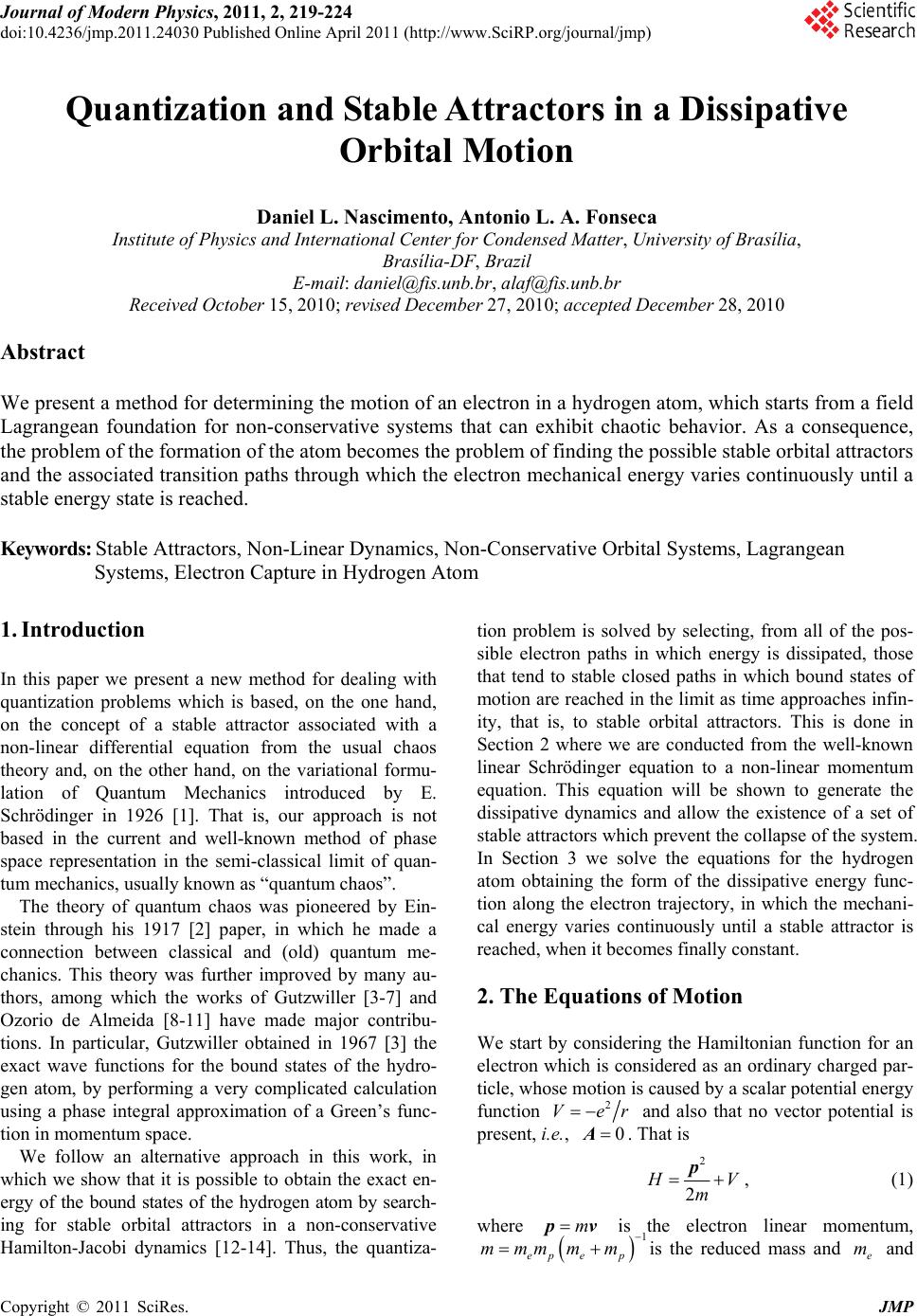 Journal of Modern Physics, 2011, 2, 219-224 doi:10.4236/jmp.2011.24030 Published Online April 2011 (http://www.SciRP.org/journal/jmp) Copyright © 2011 SciRes. JMP Quantization and Stable Attractors in a Dissipative Orbital Motion Daniel L. Nascimento, Antonio L. A. Fonseca Institute of Physics and International Center for Condensed Matter, University of Brasília, Brasília-DF, Brazil E-mail: daniel@fis.unb.br, alaf@fis.unb.br Received October 15, 2010; revised December 27, 2010; accepted December 28, 2010 Abstract We present a method for determining the motion of an electron in a hydrogen atom, which starts from a field Lagrangean foundation for non-conservative systems that can exhibit chaotic behavior. As a consequence, the problem of the formation of the atom becomes the problem of finding the possible stable orbital attractors and the associated transition paths through which the electron mechanical energy varies continuously until a stable energy state is reached. Keywords: Stable Attractors, Non-Linear Dynamics, Non-Conservative Orbital Systems, Lagrangean Systems, Electron Capture in Hydrogen Atom 1. Introduction In this paper we present a new method for dealing with quantization problems which is based, on the one hand, on the concept of a stable attractor associated with a non-linear differential equation from the usual chaos theory and, on the other hand, on the variational formu- lation of Quantum Mechanics introduced by E. Schrödinger in 1926 [1]. That is, our approach is not based in the current and well-known method of phase space representation in the semi-classical limit of quan- tum mechanics, usually known as “quantum chaos”. The theory of quantum chaos was pioneered by Ein- stein through his 1917 [2] paper, in which he made a connection between classical and (old) quantum me- chanics. This theory was further improved by many au- thors, among which the works of Gutzwiller [3-7] and Ozorio de Almeida [8-11] have made major contribu- tions. In particular, Gutzwiller obtained in 1967 [3] the exact wave functions for the bound states of the hydro- gen atom, by performing a very complicated calculation using a phase integral approximation of a Green’s func- tion in momentum space. We follow an alternative approach in this work, in which we show that it is possible to obtain the exact en- ergy of the bound states of the hydrogen atom by search- ing for stable orbital attractors in a non-conservative Hamilton-Jacobi dynamics [12-14]. Thus, the quantiza- tion problem is solved by selecting, from all of the pos- sible electron paths in which energy is dissipated, those that tend to stable closed paths in which bound states of motion are reached in the limit as time approaches infin- ity, that is, to stable orbital attractors. This is done in Section 2 where we are conducted from the well-known linear Schrödinger equation to a non-linear momentum equation. This equation will be shown to generate the dissipative dynamics and allow the existence of a set of stable attractors which prevent the collapse of the system. In Section 3 we solve the equations for the hydrogen atom obtaining the form of the dissipative energy func- tion along the electron trajectory, in which the mechani- cal energy varies continuously until a stable attractor is reached, when it becomes finally constant. 2. The Equations of Motion We start by considering the Hamiltonian function for an electron which is considered as an ordinary charged par- ticle, whose motion is caused by a scalar potential energy function 2 Ve r and also that no vector potential is present, i.e., 0 A. That is 2 2 V m p, (1) where m pv is the electron linear momentum, 1 p mm m ep e mm is the reduced mass and and e m 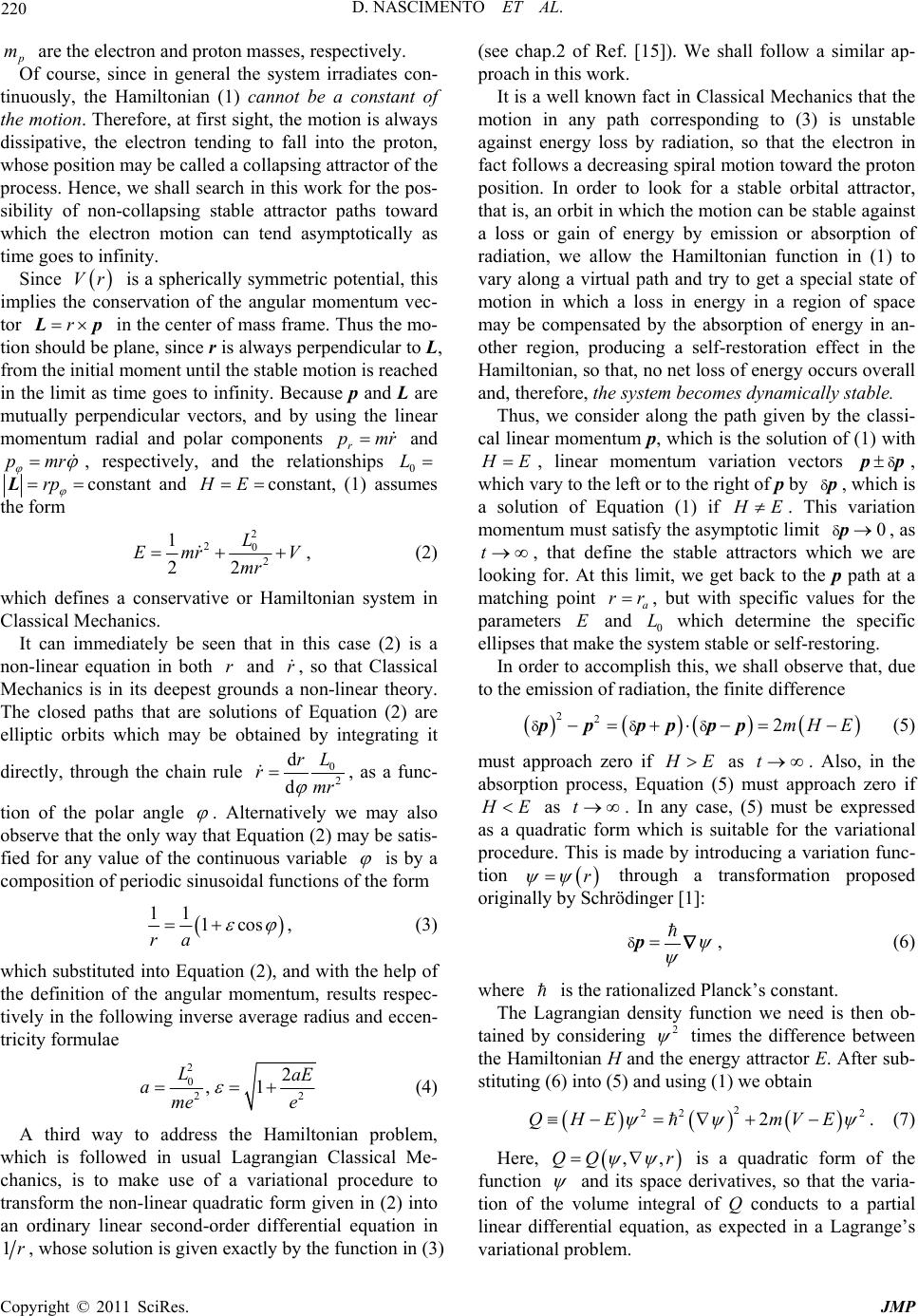 220 D. NASCIMENTO ET AL. m are the electron and proton masses, respectively. Of course, since in general the system irradiates con- tinuously, the Hamiltonian (1) cannot be a constant of the motion. Therefore, at first sight, the motion is always dissipative, the electron tending to fall into the proton, whose position may be called a collapsing attractor of the process. Hence, we shall search in this work for the pos- sibility of non-collapsing stable attractor paths toward which the electron motion can tend asymptotically as time goes to infinity. Since is a spherically symmetric potential, this implies the conservation of the angular momentum vec- tor Vr r p in the center of mass frame. Thus the mo- tion should be plane, since r is always perpendicular to L, from the initial moment until the stable motion is reached in the limit as time goes to infinity. Because p and L are mutually perpendicular vectors, and by using the linear momentum radial and polar components r pmr and pmr , respectively, and the relationships 0 L rp Lconstant and E constant, (1) assumes the form 2 20 2 1 22 L Emr V mr , (2) which defines a conservative or Hamiltonian system in Classical Mechanics. It can immediately be seen that in this case (2) is a non-linear equation in both and , so that Classical Mechanics is in its deepest grounds a non-linear theory. The closed paths that are solutions of Equation (2) are elliptic orbits which may be obtained by integrating it rr directly, through the chain rule 0 2 d d L r rmr , as a func- tion of the polar angle . Alternatively we may also observe that the only way that Equation (2) may be satis- fied for any value of the continuous variable is by a composition of periodic sinusoidal functions of the form 11 1cos ra , (3) which substituted into Equation (2), and with the help of the definition of the angular momentum, results respec- tively in the following inverse average radius and eccen- tricity formulae 2 0 2 2 ,1 LaE ame e 2 (4) A third way to address the Hamiltonian problem, which is followed in usual Lagrangian Classical Me- chanics, is to make use of a variational procedure to transform the non-linear quadratic form given in (2) into an ordinary linear second-order differential equation in 1r, whose solution is given exactly by the function in (3) (see chap.2 of Ref. [15]). We shall follow a similar ap- proach in this work. It is a well known fact in Classical Mechanics that the motion in any path corresponding to (3) is unstable against energy loss by radiation, so that the electron in fact follows a decreasing spiral motion toward the proton position. In order to look for a stable orbital attractor, that is, an orbit in which the motion can be stable against a loss or gain of energy by emission or absorption of radiation, we allow the Hamiltonian function in (1) to vary along a virtual path and try to get a special state of motion in which a loss in energy in a region of space may be compensated by the absorption of energy in an- other region, producing a self-restoration effect in the Hamiltonian, so that, no net loss of energy occurs overall and, therefore, the system becomes dynamically stable. Thus, we consider along the path given by the classi- cal linear momentum p, which is the solution of (1) with E , linear momentum variation vectors pp , which vary to the left or to the right of p by , which is a solution of Equation (1) if p E. This variation momentum must satisfy the asymptotic limit , as , that define the stable attractors which we are looking for. At this limit, we get back to the p path at a matching point 0p t a rr , but with specific values for the parameters and 0 which determine the specific ellipses that make the system stable or self-restoring. EL In order to accomplish this, we shall observe that, due to the emission of radiation, the finite difference 222mH E pp pppp (5) must approach zero if E as t. Also, in the absorption process, Equation (5) must approach zero if E as . In any case, (5) must be expressed as a quadratic form which is suitable for the variational procedure. This is made by introducing a variation func- tion t r through a transformation proposed originally by Schrödinger [1]: p , (6) where is the rationalized Planck’s constant. The Lagrangian density function we need is then ob- tained by considering 2 times the difference between the Hamiltonian H and the energy attractor E. After sub- stituting (6) into (5) and using (1) we obtain 2 22 2QHE mVE 2 . (7) Here, ,,QQ r is a quadratic form of the function and its space derivatives, so that the varia- tion of the volume integral of Q conducts to a partial linear differential equation, as expected in a Lagrange’s variational problem. Copyright © 2011 SciRes. JMP 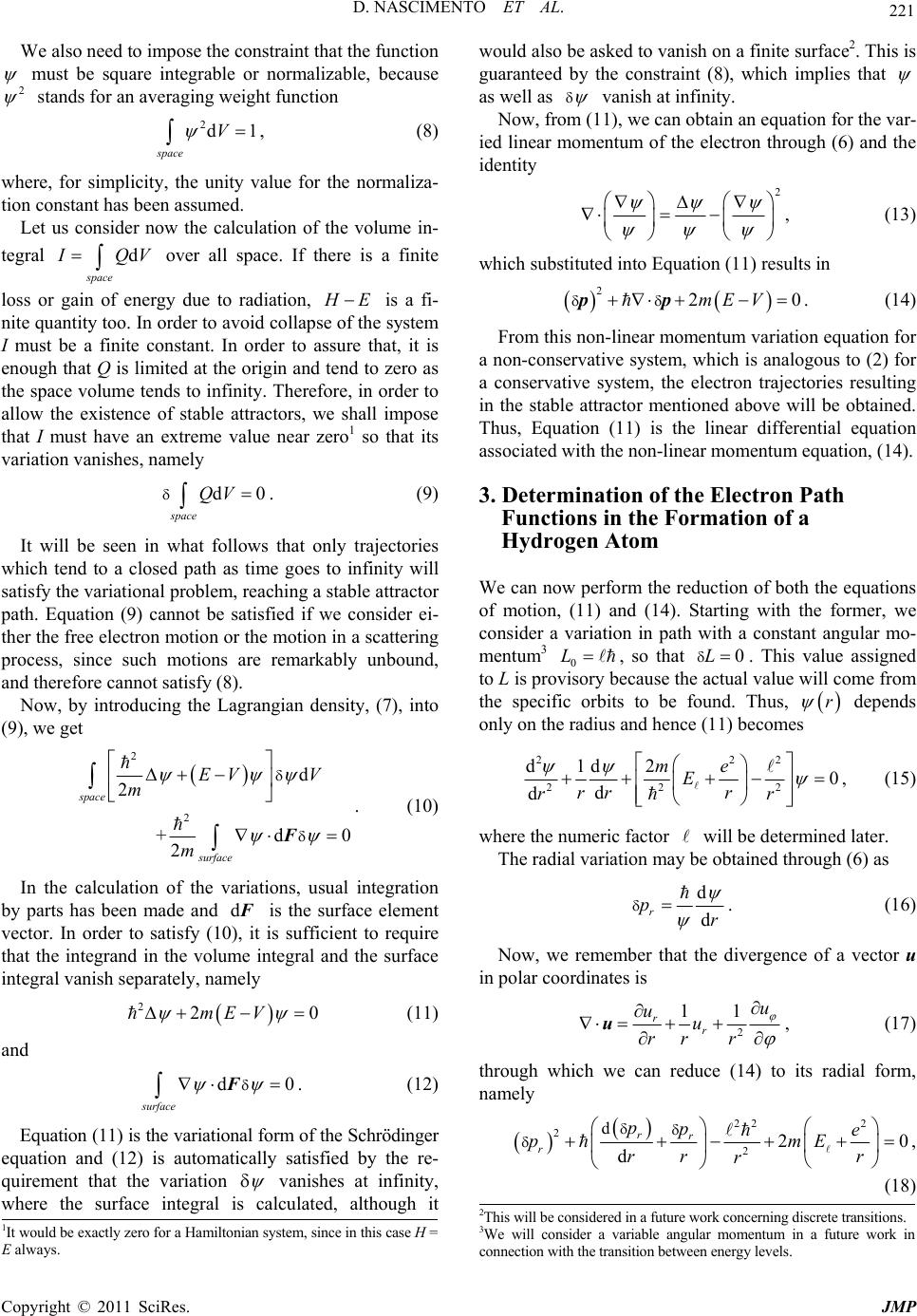 D. NASCIMENTO ET AL. 221 We also need to impose the constraint that the function must be square integrable or normalizable, because 2 stands for an averaging weight function 2d space V 1 , (8) where, for simplicity, the unity value for the normaliza- tion constant has been assumed. Let us consider now the calculation of the volume in- tegral d space QV over all space. If there is a finite loss or gain of energy due to radiation, E is a fi- nite quantity too. In order to avoid collapse of the system I must be a finite constant. In order to assure that, it is enough that Q is limited at the origin and tend to zero as the space volume tends to infinity. Therefore, in order to allow the existence of stable attractors, we shall impose that I must have an extreme value near zero1 so that its variation vanishes, namely d space QV0 . (9) It will be seen in what follows that only trajectories which tend to a closed path as time goes to infinity will satisfy the variational problem, reaching a stable attractor path. Equation (9) cannot be satisfied if we consider ei- ther the free electron motion or the motion in a scattering process, since such motions are remarkably unbound, and therefore cannot satisfy (8). Now, by introducing the Lagrangian density, (7), into (9), we get 2 2 d 2 +d 2 space surface EV V m m 0 F . (10) In the calculation of the variations, usual integration by parts has been made and d is the surface element vector. In order to satisfy (10), it is sufficient to require that the integrand in the volume integral and the surface integral vanish separately, namely 22mEV 0 0 (11) and d surface F. (12) Equation (11) is the variational form of the Schrödinger equation and (12) is automatically satisfied by the re- quirement that the variation vanishes at infinity, where the surface integral is calculated, although it would also be asked to vanish on a finite surface2. This is guaranteed by the constraint (8), which implies that as well as vanish at infinity. Now, from (11), we can obtain an equation for the var- ied linear momentum of the electron through (6) and the identity 2 0 , (13) which substituted into Equation (11) results in 22mE V pp . (14) From this non-linear momentum variation equation for a non-conservative system, which is analogous to (2) for a conservative system, the electron trajectories resulting in the stable attractor mentioned above will be obtained. Thus, Equation (11) is the linear differential equation associated with the non-linear momentum equation, (14). 3. Determination of the Electron Path Functions in the Formation of a Hydrogen Atom We can now perform the reduction of both the equations of motion, (11) and (14). Starting with the former, we consider a variation in path with a constant angular mo- mentum3 0 L , so that . This value assigned to L is provisory because the actual value will come from the specific orbits to be found. Thus, 0L r depends only on the radius and hence (11) becomes 222 22 2 d 20 d d me E rr r rr d1 , (15) where the numeric factor will be determined later. The radial variation may be obtained through (6) as d d r pr . (16) Now, we remember that the divergence of a vector u in polar coordinates is 2 11 r r u uu rr r u, (17) through which we can reduce (14) to its radial form, namely 22 2 2 2 d20 d rr r ppe pmE rr r r , (18) 2This will be considered in a future work concerning discrete transitions. 3We will consider a variable angular momentum in a future work in connection with the transition between energy levels. 1It would be exactly zero for a Hamiltonian system, since in this case H = always. Copyright © 2011 SciRes. JMP 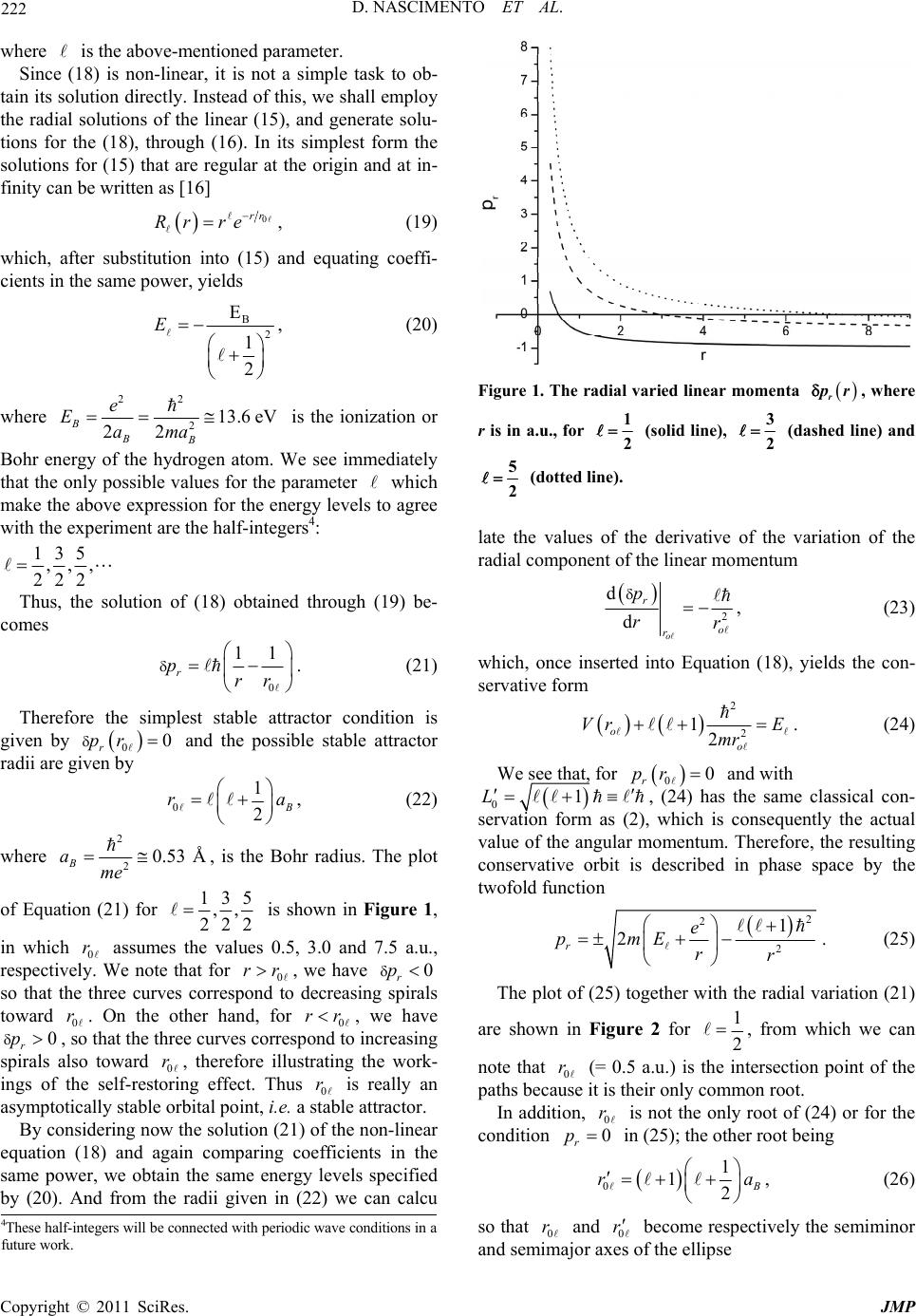 222 D. NASCIMENTO ET AL. where is the above-mentioned parameter. Since (18) is non-linear, it is not a simple task to ob- tain its solution directly. Instead of this, we shall employ the radial solutions of the linear (15), and generate solu- tions for the (18), through (16). In its simplest form the solutions for (15) that are regular at the origin and at in- finity can be written as [16] 0 rr Rr re , (19) which, after substitution into (15) and equating coeffi- cients in the same power, yields B 2 E 1 2 E , (20) where 22 213.6 eV 22 B BB e Eama is the ionization or Bohr energy of the hydrogen atom. We see immediately that the only possible values for the parameter which make the above expression for the energy levels to agree with the experiment are the half-integers4: 135 ,,, 222 Thus, the solution of (18) obtained through (19) be- comes 0 11 r prr . (21) Therefore the simplest stable attractor condition is given by and the possible stable attractor radii are given by 00 r pr 0 1 2 r a, (22) where 2 20.53 B ame Å, is the Bohr radius. The plot of Equation (21) for 135 ,, 222 is shown in Figure 1, in which 0 assumes the values 0.5, 3.0 and 7.5 a.u., respectively. We note that for 0, we have r rr0 r p so that the three curves correspond to decreasing spirals toward 0. On the other hand, for 0, we have , so that the three curves correspond to increasing spirals also toward 0, therefore illustrating the work- ings of the self-restoring effect. Thus 0 is really an asymptotically stable orbital point, i.e. a stable attractor. rrr r 0 r p r By considering now the solution (21) of the non-linear equation (18) and again comparing coefficients in the same power, we obtain the same energy levels specified by (20). And from the radii given in (22) we can calcu Figure 1. The radial varied linear momenta r r, where r is in a.u., for 1 2 (solid line), 3 2 (dashed line) and 5 2 (dotted line). late the values of the derivative of the variation of the radial component of the linear momentum 2 d d o r o r p rr , (23) which, once inserted into Equation (18), yields the con- servative form 2 2 12 o o Vr E mr . (24) We see that, for 00 r pr and with 01L , (24) has the same classical con- servation form as (2), which is consequently the actual value of the angular momentum. Therefore, the resulting conservative orbit is described in phase space by the twofold function 2 2 2 1 2 r e pmE rr . (25) The plot of (25) together with the radial variation (21) are shown in Figure 2 for 1 2 , from which we can note that 0 (= 0.5 a.u.) is the intersection point of the paths because it is their only common root. r In addition, is not the only root of (24) or for the condition 0 r 0 r p in (25); the other root being 0 1 12 r a , (26) so that 0 and 0 r r become respectively the semiminor and semimajor axes of the ellipse 4These half-integers will be connected with periodic wave conditions in a future work. Copyright © 2011 SciRes. JMP  D. NASCIMENTO ET AL. 223 Figure 2. The electron radial momenta: classical (dotted line) and varied (solid line) for 1 2 . 11 1cos ra , (27) which satisfy (25) and, thus, it is the orbital stable at- tractor searched for, where 2 0 2 22 1 and 1 2 11 1 2 B L aa me aE e (28) The corresponding average electron position for a cir- cular motion is given by the average value of the ellipse semi-axes, which agrees with the Bohr model: 2 11 22 avo oB rrr a. In order to obtain the actual electron trajectory we must integrate the varied radial linear momentum to- gether with the constant angular momentum, 0 2 dd dd r L rr pm tr , (29) 2 d1 d r r rp , (30) from which we readily obtain the equation for the elec- tron trajectory 11 1e o r r C , 0 1 r (31) whose corresponding integration constant is undeter- mined, since the followed trajectory depends on the ini- tial conditions. This means that if we consider for exam- ple , we would have and the path, Equation (31), would become a decreasing spiral. On the other hand, for we would have 00rr 0C 0 00r 0C and the path, (31), would become an in- creasing spiral. In both cases they converge toward the stable attractor o rr . The plot of the ellipse, (27), and the spirals, (31), is shown in Figure 3 for 1 2 . We can immediately write the electron energy func- tion, (1), in polar coordinates as 2 2 2 2 1 11 2 12 2 rr r H , (32) where H is in Ry and r is in a.u. The plot of H is shown in Figure 4 for 1 2 (first attractor or fundamental energy) and 3 2 (second attractor or first excited energy) of the hydrogen atom. For each value of , the self-restoring process of the stable at- tractor is quite clear: in the emission range, 0 rr , H converges monotonically to the energy attractors if E as rr . On the other hand, in the absorp- tion range, 0 0 , H first decreases from its starting energy to a point of minimum, and then it in- creases converging to the energy attractors if E as . 4. Conclusions In this paper we have introduced a different chaotic ap- proach in which we show that it is possible to obtain the exact energy of the bound states of the hydrogen atom by looking for stable orbital attractors in a non-conservative Hamilton-Jacobi dynamics. In it, a variable energy proc- ess tends asymptotically toward an energy stable attractor Figure 3. The electron trajectories in polar coordinates for 1 2 , 1 2 C and 2C : ellipse (solid line), decreasing spiral (dashed line) and increasing spiral (dot-dashed line). Copyright © 2011 SciRes. JMP 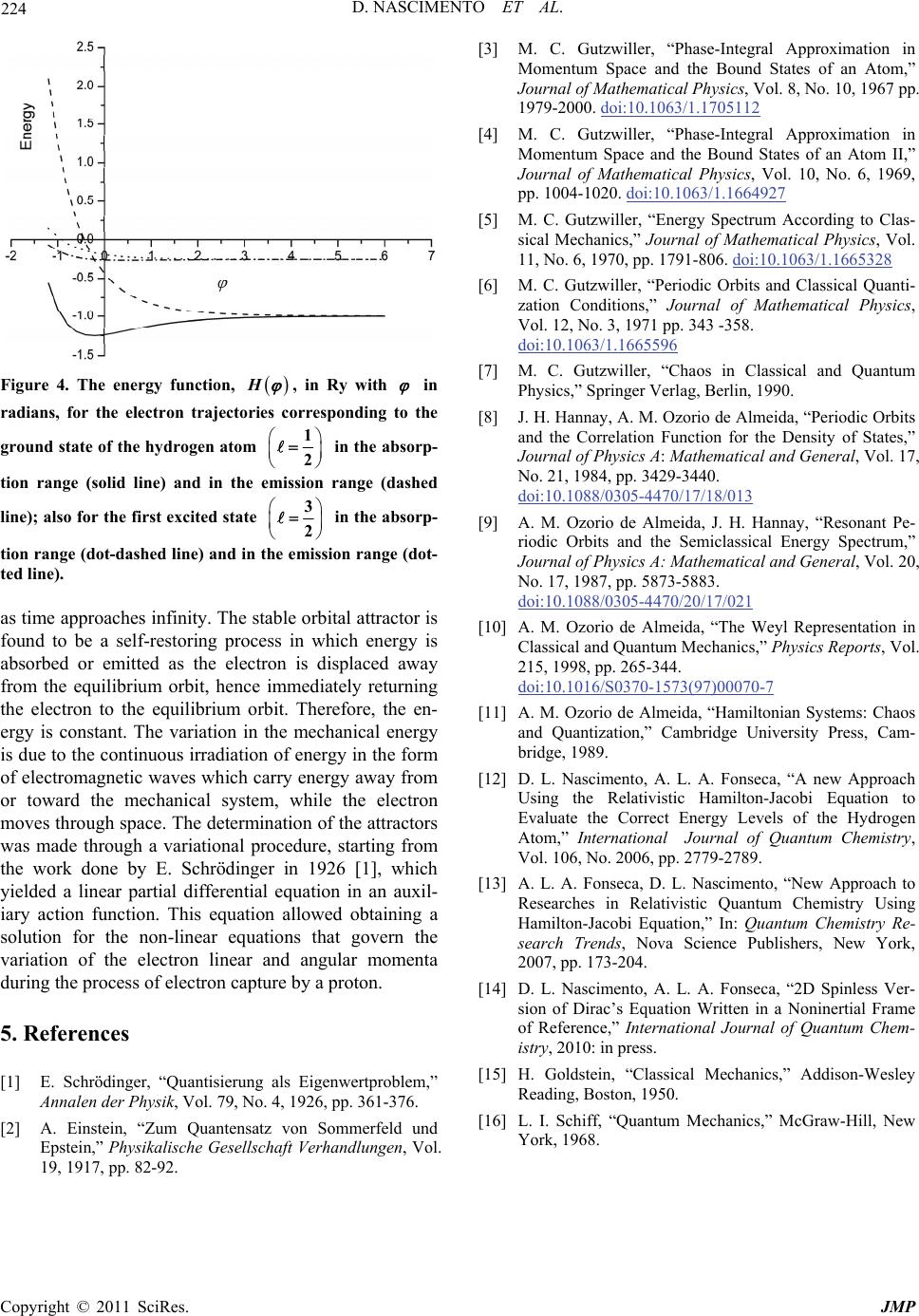 D. NASCIMENTO ET AL. Copyright © 2011 SciRes. JMP 224 [3] M. C. Gutzwiller, “Phase-Integral Approximation in Momentum Space and the Bound States of an Atom,” Journal of Mathematical Physics, Vol. 8, No. 10, 1967 pp. 1979-2000. doi:10.1063/1.1705112 [4] M. C. Gutzwiller, “Phase-Integral Approximation in Momentum Space and the Bound States of an Atom II,” Journal of Mathematical Physics, Vol. 10, No. 6, 1969, pp. 1004-1020. doi:10.1063/1.1664927 [5] M. C. Gutzwiller, “Energy Spectrum According to Clas- sical Mechanics,” Journal of Mathematical Physics, Vol. 11, No. 6, 1970, pp. 1791-806. doi:10.1063/1.1665328 [6] M. C. Gutzwiller, “Periodic Orbits and Classical Quanti- zation Conditions,” Journal of Mathematical Physics, Vol. 12, No. 3, 1971 pp. 343 -358. doi:10.1063/1.1665596 [7] M. C. Gutzwiller, “Chaos in Classical and Quantum Physics,” Springer Verlag, Berlin, 1990. Figure 4. The energy function, H, in Ry with in radians, for the electron trajectories corresponding to the ground state of the hydrogen atom [8] J. H. Hannay, A. M. Ozorio de Almeida, “Periodic Orbits and the Correlation Function for the Density of States,” Journal of Physics A: Mathematical and General, Vol. 17, No. 21, 1984, pp. 3429-3440. doi:10.1088/0305-4470/17/18/013 1 2 in the absorp- tion range (solid line) and in the emission range (dashed line); also for the first excited state 3 2 in the absorp- tion range (dot-dashed line) and in the emission range (dot- ted line). [9] A. M. Ozorio de Almeida, J. H. Hannay, “Resonant Pe- riodic Orbits and the Semiclassical Energy Spectrum,” Journal of Physics A: Mathematical and General, Vol. 20, No. 17, 1987, pp. 5873-5883. doi:10.1088/0305-4470/20/17/021 as time approaches infinity. The stable orbital attractor is found to be a self-restoring process in which energy is absorbed or emitted as the electron is displaced away from the equilibrium orbit, hence immediately returning the electron to the equilibrium orbit. Therefore, the en- ergy is constant. The variation in the mechanical energy is due to the continuous irradiation of energy in the form of electromagnetic waves which carry energy away from or toward the mechanical system, while the electron moves through space. The determination of the attractors was made through a variational procedure, starting from the work done by E. Schrödinger in 1926 [1], which yielded a linear partial differential equation in an auxil- iary action function. This equation allowed obtaining a solution for the non-linear equations that govern the variation of the electron linear and angular momenta during the process of electron capture by a proton. [10] A. M. Ozorio de Almeida, “The Weyl Representation in Classical and Quantum Mechanics,” Physics Reports, Vol. 215, 1998, pp. 265-344. doi:10.1016/S0370-1573(97)00070-7 [11] A. M. Ozorio de Almeida, “Hamiltonian Systems: Chaos and Quantization,” Cambridge University Press, Cam- bridge, 1989. [12] D. L. Nascimento, A. L. A. Fonseca, “A new Approach Using the Relativistic Hamilton-Jacobi Equation to Evaluate the Correct Energy Levels of the Hydrogen Atom,” International Journal of Quantum Chemistry, Vol. 106, No. 2006, pp. 2779-2789. [13] A. L. A. Fonseca, D. L. Nascimento, “New Approach to Researches in Relativistic Quantum Chemistry Using Hamilton-Jacobi Equation,” In: Quantum Chemistry Re- search Trends, Nova Science Publishers, New York, 2007, pp. 173-204. [14] D. L. Nascimento, A. L. A. Fonseca, “2D Spinless Ver- sion of Dirac’s Equation Written in a Noninertial Frame of Reference,” International Journal of Quantum Chem- istry, 2010: in press. 5. References [15] H. Goldstein, “Classical Mechanics,” Addison-Wesley Reading, Boston, 1950. [1] E. Schrödinger, “Quantisierung als Eigenwertproblem,” Annalen der Physik, Vol. 79, No. 4, 1926, pp. 361-376. [16] L. I. Schiff, “Quantum Mechanics,” McGraw-Hill, New York, 1968. [2] A. Einstein, “Zum Quantensatz von Sommerfeld und Epstein,” Physikalische Gesellschaft Verhandlungen, Vol. 19, 1917, pp. 82-92.
|